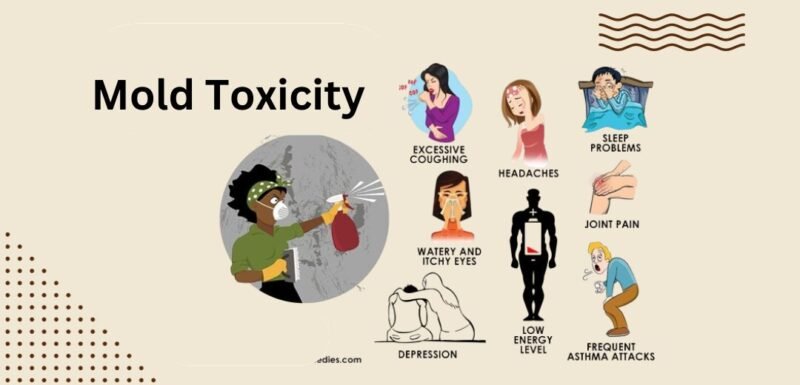Mold is a widespread and potentially dangerous intruder that may quietly penetrate our homes, workplaces, and schools. While some molds are harmless, some release chemicals that can affect human health.
Recognizing the warning symptoms of mold toxicity is critical for early detection and effective response. In this in-depth guide, we will look at the top ten indicators of mold poisoning, the link between mold toxicity and autoimmune illnesses, prevention techniques, and how to recover from mold exposure.
Mold and its Dangers
Molds are fungi that grow in moist, warm, and humid conditions, yet they can be found almost anywhere. They perform an important role in our environment by decomposing organic waste and producing antibiotics. molds reproduce using minute spores that are easily dispersed by the wind. When these spores drop on a moist or damp surface, they can germinate and cause substantial structural and cosmetic damage to structures and furniture. mold spores can cause health problems if inhaled, consumed, or come into touch with the skin.
Mold Toxicity
mold toxicity, also known as mycotoxicosis, occurs when specific types of molds produce toxic substances known as mycotoxins. The severity of mycotoxin impacts varies depending on the duration and kind of mold exposure, the specific mycotoxins present, and the individual’s health status. Early discovery and treatment are critical, as extended exposure to mold toxins can cause a variety of health complications.
The 10 Warning Signs of Mold Toxicity
Understanding the signs of mold poisoning is critical for determining potential exposure and seeking suitable treatment. While symptoms can differ between individuals, there are ten general warning indicators to look out for:
1. Fatigue and Weakness
Feeling exhausted or weak on a frequent basis may suggest mold toxicity. mold spores can enter the nasal passages and lungs, lowering oxygen levels which leads to tiredness. Mycotoxins have also been linked to decreased mitochondrial activity and increased oxidative damage, which contributes to sensations of weakness.
2. Persistent Headaches or Migraines
Frequent headaches or migraines may be an indication of mold toxicity. mold exposure and associated immunological reactions can cause headaches, which may lessen if you leave a mold-infested home.
3. Sleep Disruptions
Mold poisoning can cause insomnia and sleep problems. Symptoms may include difficulty falling asleep, awakening throughout the night, and a decrease in total sleep.
4. Neurological and Cognitive Issues
Prolonged exposure to mycotoxins can harm the neurological system, causing memory loss, confusion, and reduced balance, as well as more serious issues like neuropathy, dementia, and decreased cognitive function.
5. Mental and Mood Changes
Mold’s effect on neurotransmitter activities in the brain may cause mood changes such as depression and anxiety. Mycotoxins are thought to disrupt normal brain processes and influence the creation of neurotransmitters like dopamine and serotonin, resulting in mood abnormalities.
6. Sinus Issues
Nasal and sinus congestion are common symptoms of mold exposure. Additionally, allergic fungal sinusitis can develop when exposed to mold. A moist, moldy odor indoors could also signal a mold problem.
7. Respiratory Problems
Mold spores can cause asthma and asthma episodes, particularly in people who have mold allergies or other respiratory disorders. Mold and mycotoxin exposure can also induce or aggravate bronchitis and hypersensitivity pneumonitis, an immunological illness characterized by lung inflammation.
8. Gastrointestinal Distress
Mycotoxins, whether inhaled or consumed, can irritate the digestive tract, causing symptoms like nausea, stomach discomfort, vomiting, intestinal bleeding, diarrhea, and poor nutrient absorption. Appetite and weight changes may also occur.
9. Muscle Aches and Joint Pain
Mold exposure can lead to muscular and joint pain. Mold poisoning can lead to fungal arthritis, which is characterized by the spread of fungal infection to one or more joints. Those with compromised immune systems are more vulnerable to this infection.
10. Allergic Reactions
Mycotoxin exposure can cause allergic symptoms such as watery eyes, itchy throat, itchy skin, dermatitis, allergic fungal sinusitis, and allergic rhinitis. These symptoms usually appear quickly after exposure, and people with weaker immune systems are at a higher risk.
The time frame for acquiring symptoms following mold exposure varies substantially. Allergic reactions can occur within hours, although mold toxicity symptoms can appear over days or weeks. It is critical to get medical attention if any of these symptoms persist or worsen.
The Link Between Mold Toxicity and Autoimmune Disease
Research indicates a link between mold exposure and the development or worsening of autoimmune disorders. Mycotoxins can enter the bloodstream and induce persistent inflammation, weakening the immune system, particularly in people with weakened immunity or a hereditary susceptibility. Mold fragments and mycotoxins can also affect the human epithelial cell barrier, causing infection, inflammation, and enhanced immunological response, exacerbating autoimmune conditions.
Chronic mold exposure can worsen illnesses such as chronic inflammatory response syndrome, asthma, chronic obstructive pulmonary disease, inflammatory bowel disease, multiple sclerosis, and HIV. Mold exposure has also been related to mental health issues, such as chronic fatigue syndrome and fibromyalgia.
Prevention From Mold Toxicity
Mold grows in damp conditions, thus managing humidity levels in living and working spaces is essential for preventing its toxicity. While it is difficult to completely eradicate mold spores, lowering the danger of mold formation is critical. Here are some preventative strategies to consider:
- Use dehumidifiers to keep indoor humidity levels between 30% and 50%, particularly during humid seasons.
- Ensure sufficient ventilation, especially in moisture-prone areas like bathrooms, kitchens, and laundry rooms. Air conditioners and dehumidifiers can help prevent mold growth.
- Inspect your home on a regular basis for leaks in the roof, walls, and pipes, and repair any that are discovered quickly.
- To prevent mold growth, clean and dry any moist surfaces within 24-48 hours.
- Avoid installing carpets in locations prone to water use or damage, such as bathrooms or basements.
How to Recover from Mold Toxicity
The recovery from mold poisoning involves numerous phases, beginning with preventing or removing the source of exposure. While human data is limited, glutathione, probiotics, and vitamins A, C, and E may help alleviate the symptoms and underlying difficulties linked with mold toxicity. Medical treatment focuses on providing supportive care to ease symptoms. Antihistamines, nasal steroids, and decongestants can help minimize allergic reactions and treat sinus and respiratory problems.
In addition to medical treatment, natural therapies such as dietary changes, stress management, and increased physical exercise may help to alleviate symptoms and improve overall quality of life. Long-term management of mold toxicity entails continuing to prevent mold exposure, maintaining a healthy lifestyle, and maybe taking medication or supplements on a regular basis, depending on individual circumstances. It is critical to monitor for any recurrence of symptoms, as re-exposure to mold might cause the illness to reappear.
Conclusion
Mold poisoning is a serious health risk that can have a significant influence on people’s well-being. Recognizing the warning symptoms, understanding the link to autoimmune illnesses, and applying prevention tactics are all critical stages in protecting against mold toxicity. If you suspect mold exposure and are experiencing persistent symptoms, consult a healthcare provider who has experience treating mold toxicity. By taking proactive steps and putting your health first, you may reduce the hazards connected with mold toxicity and create a safer environment for yourself and your loved ones.



